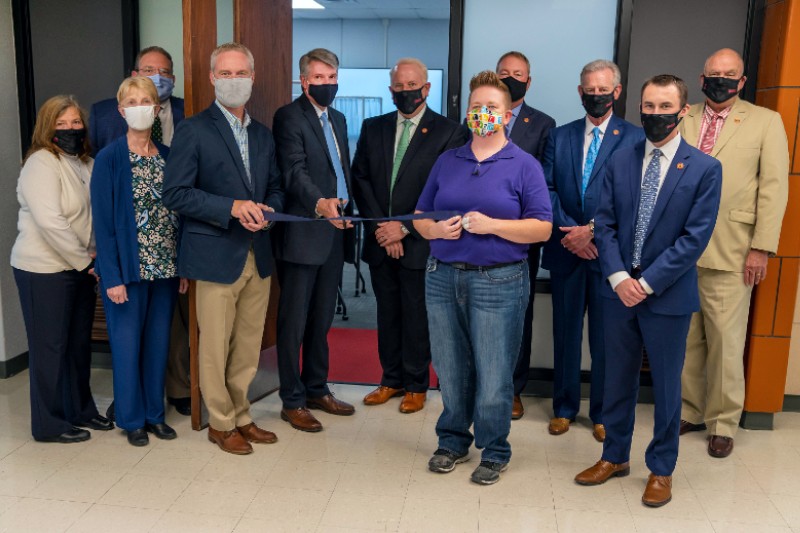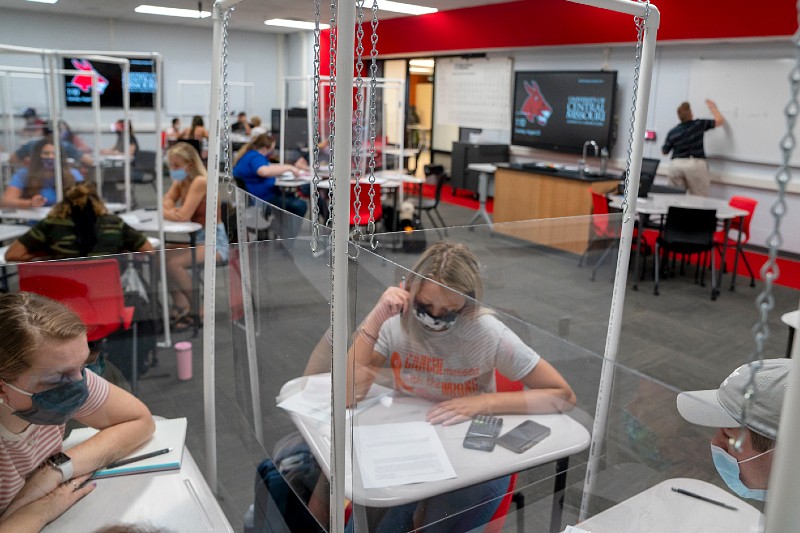Breadcrumb
Chemistry Classroom Transformation Geared to Student Success
By Jeff Murphy, September 2, 2020
 Members of the Board of Governors and the School of Natural Sciences participate in
a ribbon-cutting ceremony for the new chemistry smart classroom in Wilson C. Morris
Science Building Room 422. Participants, left to right, were: Mary Dandurand, board
member; Alice Greife, dean of the College of Science, Health and Technology; Phil
Bridgmon, provost and vice president for academic affairs; Scott Lankford, chair of
the School of Natural Sciences; Roger J. Best, UCM president; John Collier, board
member; Mandy Blackburn, associate professor of chemistry; Ken Weymuth, board member;
Steve Abney, board president; Zac Racy, student board member; and Gus Wetzel, II,
board member.
Members of the Board of Governors and the School of Natural Sciences participate in
a ribbon-cutting ceremony for the new chemistry smart classroom in Wilson C. Morris
Science Building Room 422. Participants, left to right, were: Mary Dandurand, board
member; Alice Greife, dean of the College of Science, Health and Technology; Phil
Bridgmon, provost and vice president for academic affairs; Scott Lankford, chair of
the School of Natural Sciences; Roger J. Best, UCM president; John Collier, board
member; Mandy Blackburn, associate professor of chemistry; Ken Weymuth, board member;
Steve Abney, board president; Zac Racy, student board member; and Gus Wetzel, II,
board member.
WARRENSBURG, MO – General Chemistry I and II courses can be challenging to many students,
but through a recent classroom transformation in the University of Central Missouri
Wilson C. Morris Science Building, the university hopes to enhance student success
through interactive learning.
The chemistry program’s new smart classroom in WCM Room 422 was toured by the university’s Board of Governors Aug. 20, shortly after conducting a ribbon-cutting ceremony to celebrate its launch. When the fall semester began Aug. 24, the classroom became operational, but with temporary modifications to enhance social distancing and enhance safety related to COVID-19. The room was designed to accommodate up to 48 students.
Scott Lankford, chair of the School of Natural Sciences, said the classroom is needed to help students overcome hurdles they have faced with two General Chemistry courses in a traditional classroom setting. These courses serve chemistry majors, but are also taken by students pursuing other academic paths, including majors in biology, kinesiology, medical laboratory science, and radiological technology, to mention a few.
According to Lankford, the historic method of teaching the General Chemistry courses involves instructors delivering content to students by conducting traditional lectures four days per week. Then, students work outside the classroom using educational software to practice problem-solving skills that are essential to grasping the subject matter.
In trying to determine why some students struggled with these courses, Lankford said a series of meetings with students and faculty took place in 2019. Through those sessions, it was discovered that once students left the classroom, they weren’t properly using the educational software for problem solving that is essential to their success in the course. This, he noted, “short-circuited the link between the didactic lecture content being enforced by practice that day. The chemistry faculty identified that flipping the classroom and increasing the time students spent engaged in the problem-solving aspect of chemistry became our clear path, but UCM lacked a classroom to support the pedagogy.”
Thanks to a total of $145,652 in funding assistance through three sources - a Title III grant managed by by Shaunte Montgomery; funds from the College of Health, Science and Technology (CHST); and funds from the President's Unrestricted Foundation Fund - the existing classroom was transformed from a static instructor podium and student desk environment to a fully interactive classroom. Lankford said this room allows school faculty to interact at a new and more efficient level with students while they are in the lecture and lab environments.
“This will fundamentally change the learning environment into a collaboration to learn,
and not a simple give and take of information flow,” he noted. Students taking General Chemistry I and General Chemistry II courses at the University
of Central Missouri this fall will develop problem-solving skills by working in groups
of four and utilizing technology that promotes interactive learning. This is available
in the new smart classroom located in room 422 of the Wilson C. Morris Science Building.
Students taking General Chemistry I and General Chemistry II courses at the University
of Central Missouri this fall will develop problem-solving skills by working in groups
of four and utilizing technology that promotes interactive learning. This is available
in the new smart classroom located in room 422 of the Wilson C. Morris Science Building.
The room was designed through a collaboration between the chemistry faculty and key
staff members from CHST and the Office of Technology, including Elmer Ragus, R.J.
Kippes, Ken Baker, and Ray Walters, and is arranged in groups, each with up to four
students facing each other who function as a team. Technology includes five electronic
instructional panels, one of them is an 80-inch, fully interactive touch-screen monitor.
All five monitors can be controlled by the instructor or turned over to a student
group to remote connect. Students can remote connect through the laptop issued to
the group, or any available digital device, which allows them to display their work
and utilize different graphics and animations to help illustrate their problem-solving
techniques. The room also is equipped with an interactive camera that makes it possible
to project demonstrations to each instructional panel. Laptops provided to the student
groups are loaded with software that is for all course interactions and required chemistry-based
activities, and is available for students to load on their own systems. Additional
equipment in the room allows the class to be live-streamed, including the ability
to live-stream a visiting professor or guest speaker.
Jason Holland, professor and chemistry program coordinator, said another important part of this classroom transformation was to move the instructor from a podium at the front the room to the center of the classroom so that the instructor is better integrated with their students. This position also gives the instructor a better focal point in which they can observe and engage students working in the interactive environment.
“We’ll be able to see six or seven students at once versus a couple of students in a row over the course of time,” Holland said. “So we can identify misconceptions and missteps quickly, but also point out good problem-solving skills and be able to describe different methods that students choose.”
“In chemistry, there is a lot of problem solving, and when students are sitting in stacks of rows, and you are standing out front as an instructor, it’s really difficult to get an idea what the students are doing work-wise on paper,” he said. “With this room, we’ll be able to see what the students are doing on paper because they are going to have whiteboards and they will project (their work) on screen or the walls around the room.”
Mandy Blackburn, associate professor of chemistry, led the board through a demonstration using technology in the new chemistry classroom. She emphasized that the room is designed to strengthen interaction and discussion between students.
“We can throw them (students) five or six problems at one time, have each group of students tackle that problem, write their solution on the whiteboard and then discuss and defend how one approach is different, better or worse than the other, so they can share information and learn about how they are solving the problem,” she said.
“Communication is one of those key skills in chemistry,” Blackburn added. “Talking about it funnels that information through a different channel in your brain and you can actually learn it better and deeper. A classroom like this actually facilitates those discussions.”
Lankford expressed his appreciation to university sources that contributed funding to this classroom at a time when the institution faced financial pressures.
“For the university to be this dedicated to advancing the pedagogy during tough fiscal times makes me proud to be a Mule,” Lankford said. “This is a classroom that you would be proud to have on any campus, much less doing it in the middle of a pandemic and a financial downturn.”








